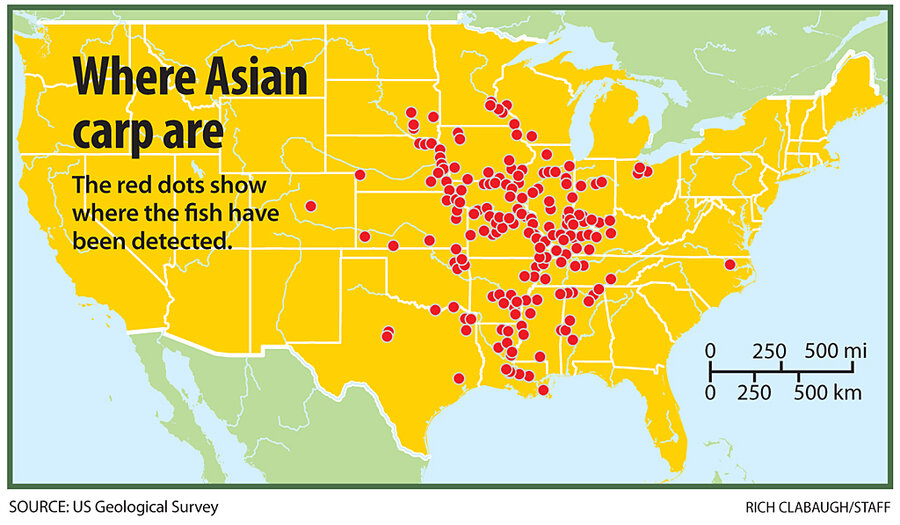Asian carp invasion: Can we fish our way out of the problem?
Loading...
| Starved Rock State Park, Ill.
Last spring in Little Rock, Ark., officials of the Aquatic Nuisance Species Task Force dined on one of the biggest nuisances of them all: Asian carp.
"It was very good," says Ron Brooks, head of fisheries in Kentucky.
Carp native to China escaped from Southern fish hatcheries in the 1970s, where they were being cultivated to eat algae in fishponds. They've been spreading ever since. They are now found in much of the Mississippi River Basin, from Louisiana to Minnesota. In some places – such as the Illinois River downstream from Starved Rock State Park – 9 out of 10 fish are Asian carp.
Stopping them before they reach the Great Lakes is the aim of a national campaign involving a broad range of biologists, state and federal agencies, and even the White House. This year, the US Army Corps of Engineers turned on a third electric barrier in a shipping canal near Chicago to halt the carp's incursion. Officials are also trying to identify and block other potential links between the Mississippi and the Great Lakes, as they did last year by erecting a quarter-mile-long mesh fence in a marsh in northeastern Indiana. Meanwhile, researchers are hunting for chemical or genetic methods of disrupting carp reproduction.
Many people say there's a better way to control Asian carp: Eat them. Government officials, university researchers, and businesses are working to build a commercial fishing industry capable of harvesting enough Asian carp to reduce their numbers and stop their expansion.
"There's no other short-term method that we have that's likely to have any substantial effect on these populations," says Duane Chapman, a carp expert with the US Geological Survey in Columbia, Mo.
Indeed, some biologists doubt that current efforts are enough to keep Asian carp out of the Great Lakes. Promoters of commercial fishing say that "taking the battle downstream" would both help states where the carp are already established and reduce the chances that the fish will migrate into the Great Lakes.
Fishermen have already been catching Asian carp for at least a decade, and in growing numbers. Steve McNitt, sales director at Schafer Fisheries in Thomson, Ill., the Midwest's largest fish processor, says his company bought 20 million pounds last year – much of which was minced for domestic use or exported whole to Brazil, Israel, and China.
Orion Briney, who fishes almost exclusively for Asian carp on the Illinois River, says his two crews can bring in as much as 25,000 pounds of carp a day using nets and 30-foot aluminum boats. "It's been good for us," he says.
Illinois is also paying fishermen to remove Asian carp from waterways just south of Chicago. This effort has succeeded in reducing carp numbers at the leading edge of their expansion, says Kevin Irons of the Illinois Department of Natural Resources.
Proponents of a carp industry say fishermen could catch many more than they do now. The problem is what comes afterward. The Mississippi Basin lacks enough processing plants, the consequence of a long decline in commercial fishing, industry and other experts say. There's also a shortage of markets. Some officials have extolled the potential for exporting large quantities of carp to China, but the logistics are difficult – the fish need to be taken quickly to scarce processing plants to be frozen, and the Chinese are very exacting about the quality – and the margins are slim.
"There are a lot of plans out there," says Mr. McNitt, who says he gets daily calls about Asian carp. "To make them come together is very difficult."
Some argue that governments should do more to subsidize an Asian carp industry, including placing a bounty on them. Last year, Illinois gave $2 million to Big River Fish Corp., a company in Pearl, Ill., to outfit a plant that can flash-freeze carp for export. (The plant has yet to open.)
This fall, researchers at Southern Illinois University, Carbondale are conducting an experiment to determine exactly how much incentive fishermen and processors need. They have ordered a million pounds of fish meal (a product used for pet food and feed on fish farms) made from Asian carp at a cost of $1.1 million, and they are going to see what happens.
"If it's a viable model, we'll keep going with it," says Jim Garvey, a fish ecologist.
Perhaps the biggest challenge is getting Americans to eat Asian carp. "They look horrible," Mr. Brooks says. "They're bony." Yet, as he and others attest, they taste just fine.
Efforts to market the fish in the United States have been slow to take hold. One of the few restaurants serving Asian carp regularly is Beasley's Fish Market in Grafton, Ill. The eatery began offering carp as a special last spring after patrons started asking about it.
"Mostly they were surprised that it was good," says Deborah Beasley, the restaurant's manager. "In this area, if you just say 'carp,' it has a very negative connotation."
Not everyone is enthusiastic about large-scale fishing for carp. Some biologists worry that a big Asian carp industry would create pressure to maintain carp populations, not get rid of them. Still, it's hard for some to resist a fish that has become so abundant.
"We're finding new ways to use it all the time," says McNitt. "We make jerky. We're setting up to make hot dogs. We're going to make fish sandwiches, breaded or unbreaded. There's a worldwide need for cheap protein, and I think it's one of those things that fit the bill. I think the future is bright for this fish."






